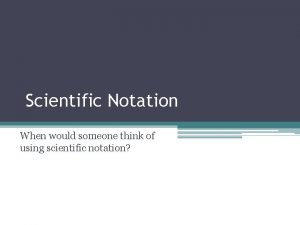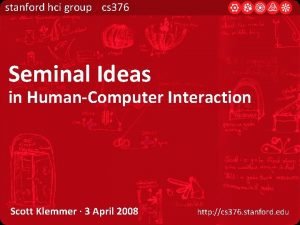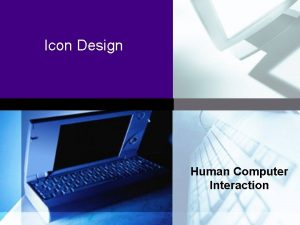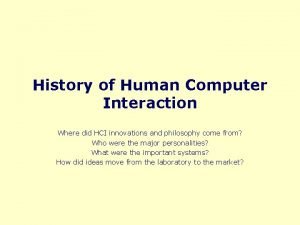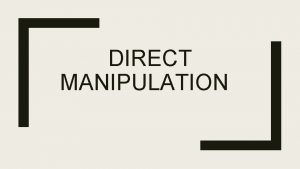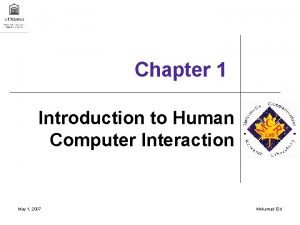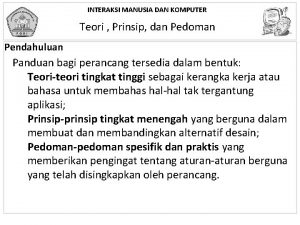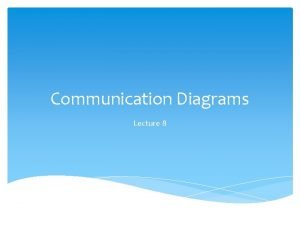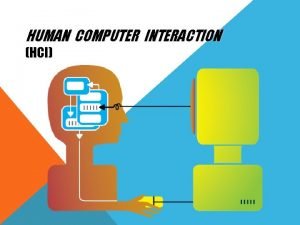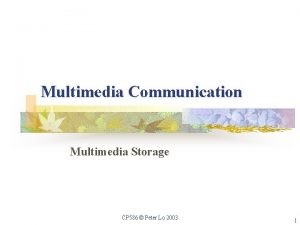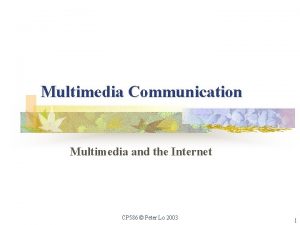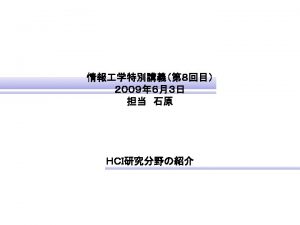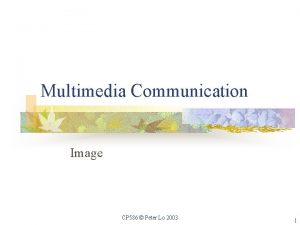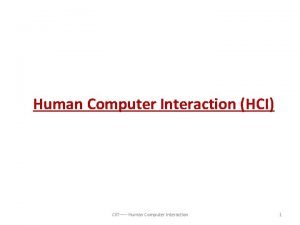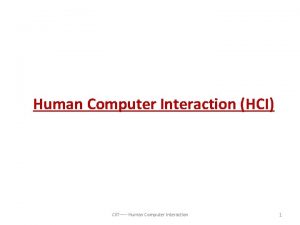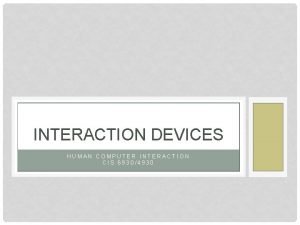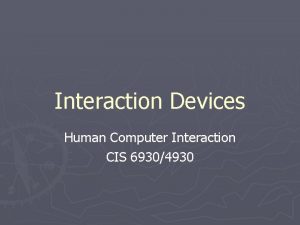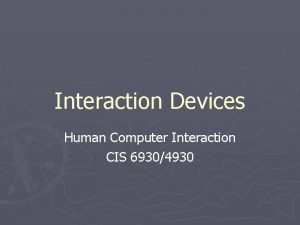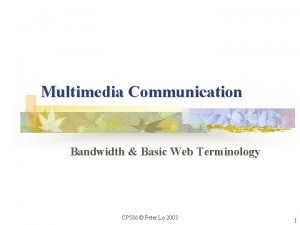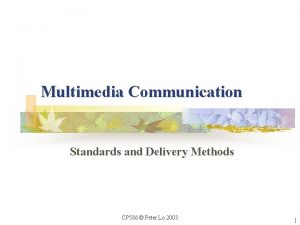Multimedia Communication Human Computer Interaction CP 586 Peter


















- Slides: 18

Multimedia Communication Human Computer Interaction CP 586 © Peter Lo 2003 1

User Interface n n n Those aspects of the system that a user comes in contact with. An input language for the user, an output language for the machine, and a protocol for interaction. Example: n n n GUI OS : Microsoft Windows 95. GUI application : Microsoft Word 97. Line based OS : Unix, DOS. Banking: ATM, EFTPOS. Phone Banking: National Australia Bank, BPAY and Commonwealth. Other: Video recorder and a microwave. CP 586 © Peter Lo 2003 2

User Interface Design n User interface design requires an understanding of Human-Computer Interaction (HCI) and usercentered design principles. The Human-Computer Interface is the part of the computer we actually see. Although the product may consist of millions of software and hardware components, the interface is the component that interacts with a user and allows us to achieve something with a given application. CP 586 © Peter Lo 2003 3

Human Computer Interaction n n A set of processes, dialogues, and actions through which a human user interacts with a computer. A discipline concerned with design, evaluation and implementation of interactive computing systems for human use. HCI design is the engineering process of designing interactive computer systems so that they are efficient, pleasing, easy to use and do what people want. Design of the human-computer interface is part of a wider subject area of HCI. CP 586 © Peter Lo 2003 4

Disciplines Contributing to HCI n n n Computer Science. Cognitive, social and organisational Psychology. Ergonomic and Human Factors. Linguistics. Artificial Intelligence. Engineering and Design. CP 586 © Peter Lo 2003 5

The Goals of HCI n n n To develop or improve the safety, utility, effectiveness, efficiency and useability of systems that include computers. Poor interfaces can lead to system failure or inefficient usage. A bad interface will cause the rejection of a system even though it may have an excellent internal software design. CP 586 © Peter Lo 2003 6

HCI specialists strive to : n n n Understand the factors (psychological, ergonomic, organisational and social) that determine how to use computers effectively. Develop tools and techniques to help designers ensure that computer systems are suitable for their desired application. Achieve efficient, effective and safe interaction with computer systems. CP 586 © Peter Lo 2003 7

HCI and Multimedia n n n When developing multimedia applications, HCI is extremely important. Output devices provide information and feedback in a form perceptible by a human. Multimedia interfaces must be designed to be easy to use, efficient, intuitive and effective. CP 586 © Peter Lo 2003 8

Gestalt Psychology n n The natural ability of a viewer to organise information into sensible groups. The ability to separate images into the figure and the background. The tendency for the eye to continue viewing in a line. The ability to perceive groups of objects according to their similarity. CP 586 © Peter Lo 2003 9

Cultural differences n Beware of different significance of icons (eg symbol for mail box, hand gestures). n Colours: white for mourning in Japan, red for Chinese weddings. n Words: “trash”, “garbage”, “rubbish”. n Cultural difference between programmers and users!! CP 586 © Peter Lo 2003 10

Metaphors and Principles n n Metaphor : The application of a word or phrase to an object or concept which it does not literally denote, in order to suggest comparison with another object or concept. It is often useful to use a metaphor to symbolise and simplify interaction between a user and a computer. CP 586 © Peter Lo 2003 11

Eight User-centered Design Principles 1. Understand the Underlying Business Functions 2. Maximize Graphical Effectiveness 3. Profile the System's Users 4. Think Like a User 5. Use Prototyping 6. Design a Comprehensive Interface 7. Continue the Feedback Process 8. Document the Interface Design CP 586 © Peter Lo 2003 12

Good User Interface Design n Good user interface design is based on a combination of Ergonomics (人類 作學), Aesthetics (知覺), and Interface Technology. n n n Ergonomics – How people work, learn and interact with computer. Aesthetics – How an interface attractive and easy to use. Interface Technology – Provide the operational structure for design objective. CP 586 © Peter Lo 2003 13

User Interface Design Guidelines n n n n Focus on Basic Objectives Build an Interface that is Easy to Learn and Use Provide Features that Promote Efficiency Make it Easy for Users to Obtain Help or Correct Errors Minimize Input Data Problems Provide Feedback to Users Create an Attractive Layout and Design Use Familiar Terms and Images CP 586 © Peter Lo 2003 14

User Interface Controls n The designer can include many control features, such as Menu Bars, Toolbars, Dialog Boxes, Text Boxes, Toggle Buttons, List Boxes, Scroll Bars, Drop-down List Boxes, Option Buttons, Check Boxes, Command Buttons, Spin Bars, and Calendars among others. CP 586 © Peter Lo 2003 15

User Interface Controls CP 586 © Peter Lo 2003 16

Input Design Issues n n Data Capture is the identification and recording of source data. Data Entry is the process of converting source data into computer-readable form and entering it into the information system. CP 586 © Peter Lo 2003 17

Six Main Input Design Objectives 1. 2. 3. 4. 5. 6. Select a suitable input and data entry method Reduce input volume Design attractive data entry screens Use validation checks to reduce input errors Design required source documents Develop effective input controls CP 586 © Peter Lo 2003 18
 586 400 000 in scientific notation
586 400 000 in scientific notation Stanford human computer interaction
Stanford human computer interaction Hci icon
Hci icon Example of paradigm in hci
Example of paradigm in hci Human input and output channels in hci
Human input and output channels in hci History of hci
History of hci Direct manipulation is
Direct manipulation is Hci chapter 1
Hci chapter 1 Uhcd adalah
Uhcd adalah Prinsip imk
Prinsip imk Interaction design syllabus
Interaction design syllabus Pengertian hci
Pengertian hci Human computer interaction alan dix
Human computer interaction alan dix Human computer interaction diagram
Human computer interaction diagram Ergonomics in human computer interaction
Ergonomics in human computer interaction Hci adalah
Hci adalah Multimedia becomes interactive multimedia when
Multimedia becomes interactive multimedia when Non linear multimedia example
Non linear multimedia example Csc253
Csc253
